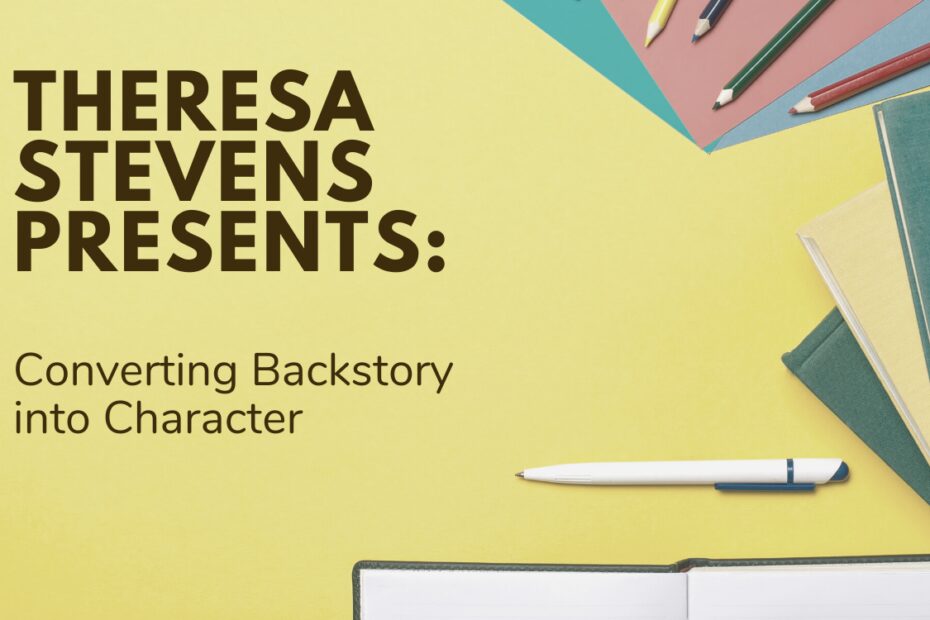Theresa Stevens joins RU once again (yay!) to lead us through the process of character development. Fire up your printers RU writers, this one is a keeper!

That single fact drove most of the character creation, and was the answer to almost every question about this character. What was Ashley’s romantic history? Light and sporadic, because she can’t trust men because her father was an abusive alcoholic. What does she look for in a man? Sobriety. And so on, each question leading back to that single backstory detail. No matter the question, the answer was, “Daddy was a mean drunk.” In fact, here is what my friend offered as a brief character description:
She’s been conditioned that people will always disappoint her. Her father disappoints her by constantly falling off the wagon. Every time she puts any faith in him, he blows it. Her mother (although she has a good relationship with her) disappointed her because she never had the strength to leave Ashley’s dad and give Ahsley a more stable environment.
This is good, as far as it goes, but it doesn’t go far enough. My friend, to her credit, knew something was off with this character but was having trouble grasping the smoke. The problem is one of focus. Daddy’s not in this book. The story isn’t about letting go of the original family. This is a straightforward romance novel with a strong external plot that doesn’t involve Ashley’s dad at all. So this means that every time we were talking about the backstory, we were talking about events that occurred outside the scope of this plot. Those events have no relevance OTHER THAN the way they shaped Ashley’s character.
So we had to reframe Ashley’s character. We had to focus on the results (how she behaves in real story time), rather than the cause (Daddy was a mean drunk).
Step one in this exercise was to come up with a list of character traits. I forbid my writing friend from mentioning Ashley’s father at all. I told her to come up with a simple list of character traits to describe Ashley. Each trait should be expressed in a word or two. Here is what she sent:
Suspicious
Controlling
Self-contained
Lonely
Miserly (in that she can pinch a penny until the head pops off. LOL)
Dependable (if she wants it done, she does it herself)
Driven
That’s a sad list, isn’t it? The traits seem overwhelmingly negative. This is a romantic heroine we’re talking about. The reader will want to be able to identify with this character, so that negativity might be a barrier. Also, keep in mind that we’re trying to understand how a formative situation shapes character. Ashley was forged in fire, and these kinds of circumstances can make you hard, but they can also make you strong.
So the next step was to challenge my friend to find a positive way to express these traits. Almost every aspect of character can be positive or negative, depending on how it is expressed in the story. So I asked her to look at her list and think of positive ways these traits might manifest. For example, a suspicious character might be hard to fool, which would be a good trait in a romantic suspense novel, right?
Here is what my friend generated:
Negative Positive
Suspicious Won’t be fooled
Controlling Orderly
Miserly Responsible with money
Self-contained Self-sufficient
Lonely Doesn’t need to be entertained
Driven Wants to do a good job
Now we understand the different ways that the same basic trait might be expressed in the course of the plot. After getting this far and looking at her list more closely, we realized that Ashley’s core trait is that she’s cautious. This caution is expressed in multiple ways, and almost every trait on the above list, both positive and negative, can be seen as an expression of that cautiousness. Now we’re starting to really understand what drives Ashley, but there’s still one more step.
That final step is figuring out how these traits manifest in the world Ashley inhabits. This is where things get really interesting. Look at that list and think about some aspect of Ashley’s present world and how it might be impacted by each trait. Do you see any potential conflicts? I do. For example, if she’s good with money, but miserly, does she buy an investment property like an apartment building to live in, or a tiny condo with low payments, or something else? If she’s self-contained and entertains herself, does she have a great television system and movie collection, or does her miserliness keep her from spending money on this sort of thing? If she’s put on a work project team with a sexy, smoking hot hero, will she agree to work late and discuss the project over drinks?
By thinking of these kinds of potential issues in the character formation stage, you not only develop a deeper understanding of the character, but you develop a sense of how different aspects of that character are prioritized. Which will she value more, saving money or protecting her privacy? In times of stress, does she hide or does she try to control everything? In the end, when this exercise is complete, you will have a more fully developed character, and you will understand better how to portray her in a deep, complex way.
